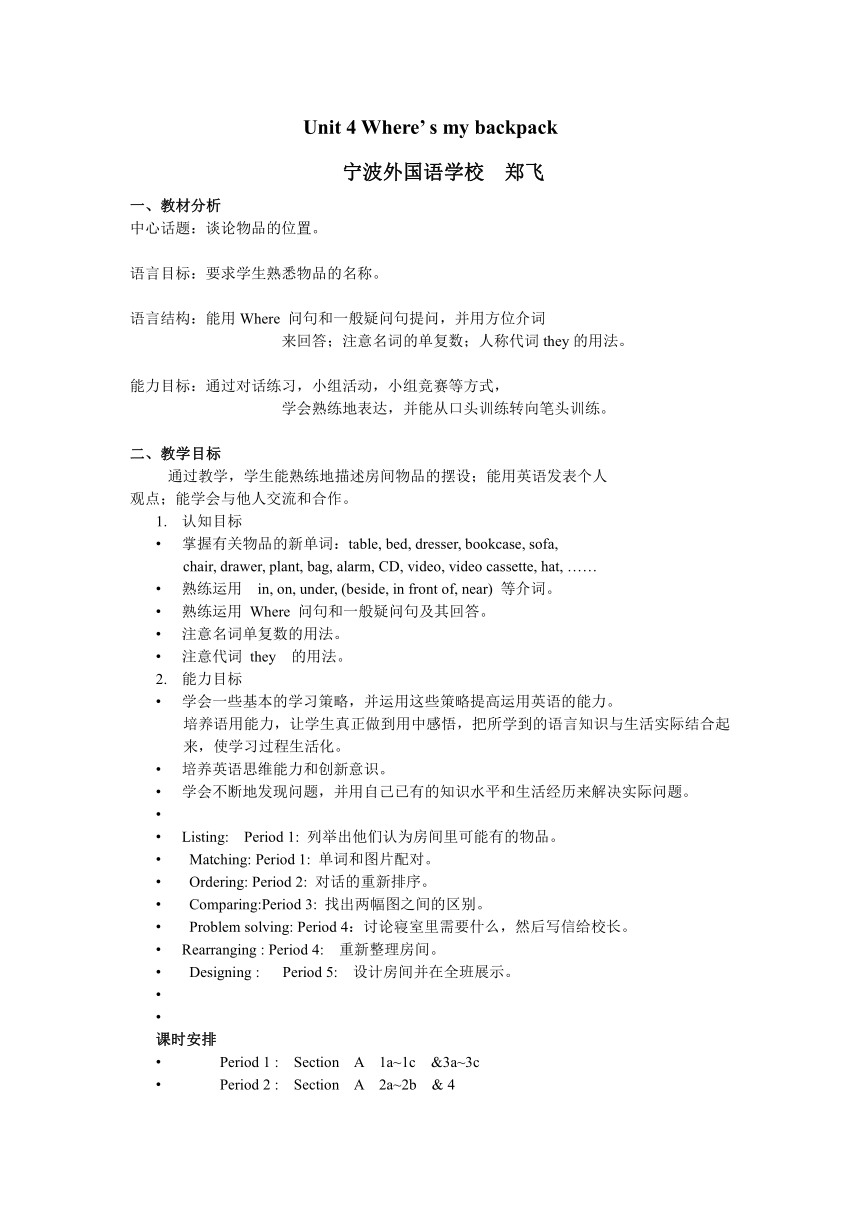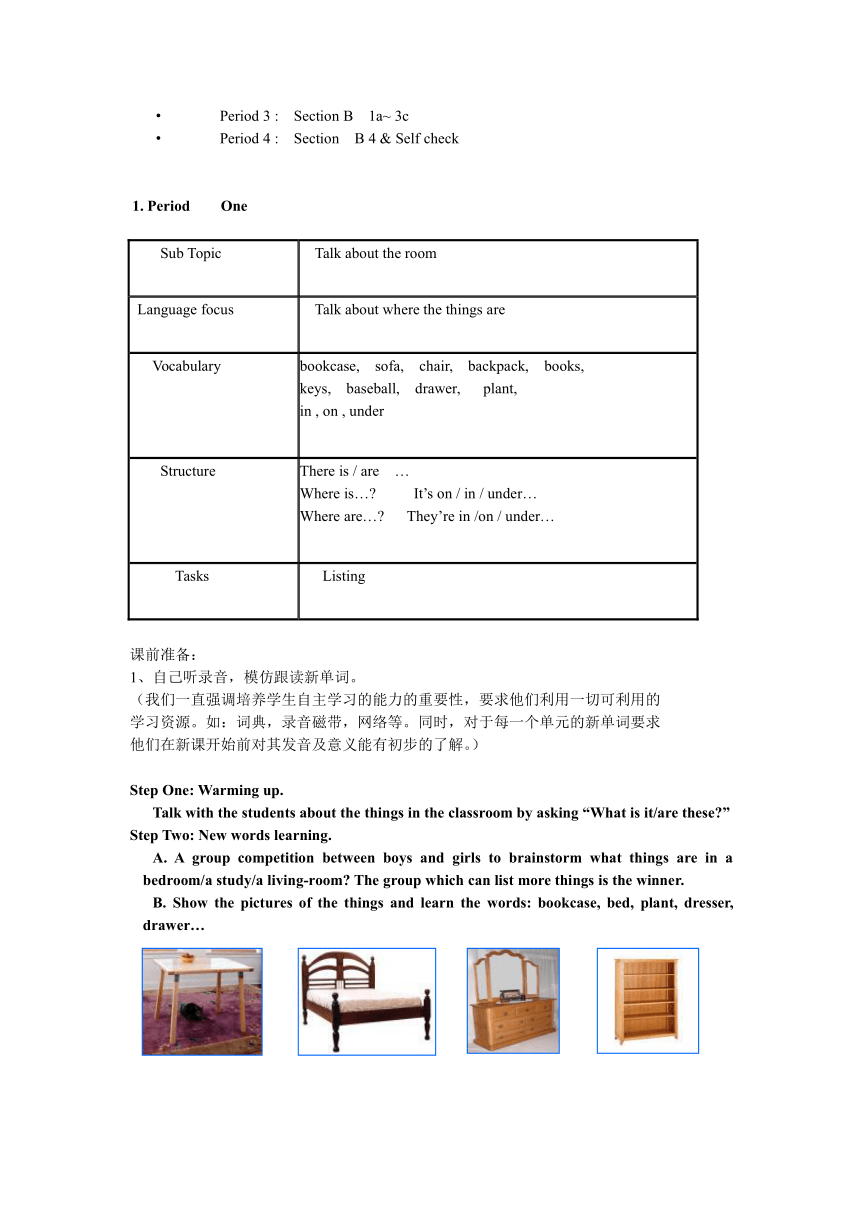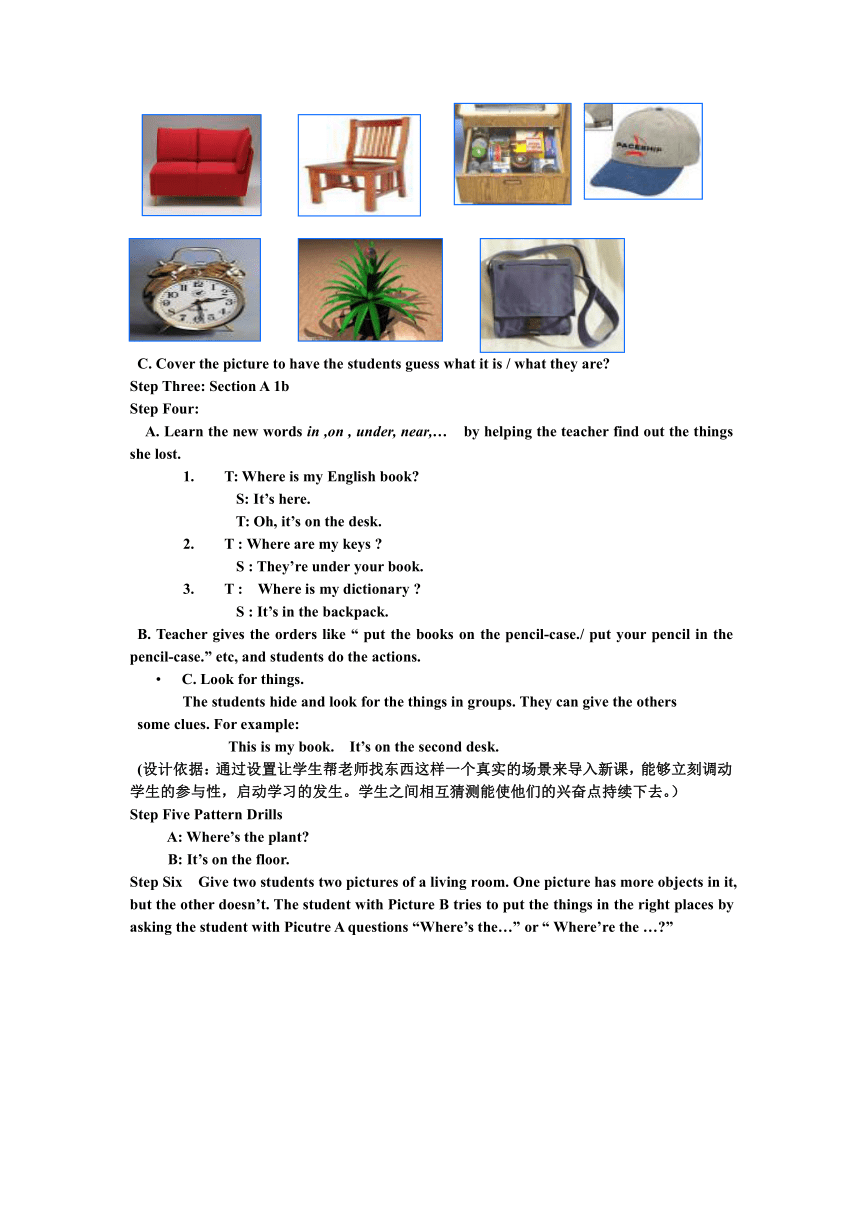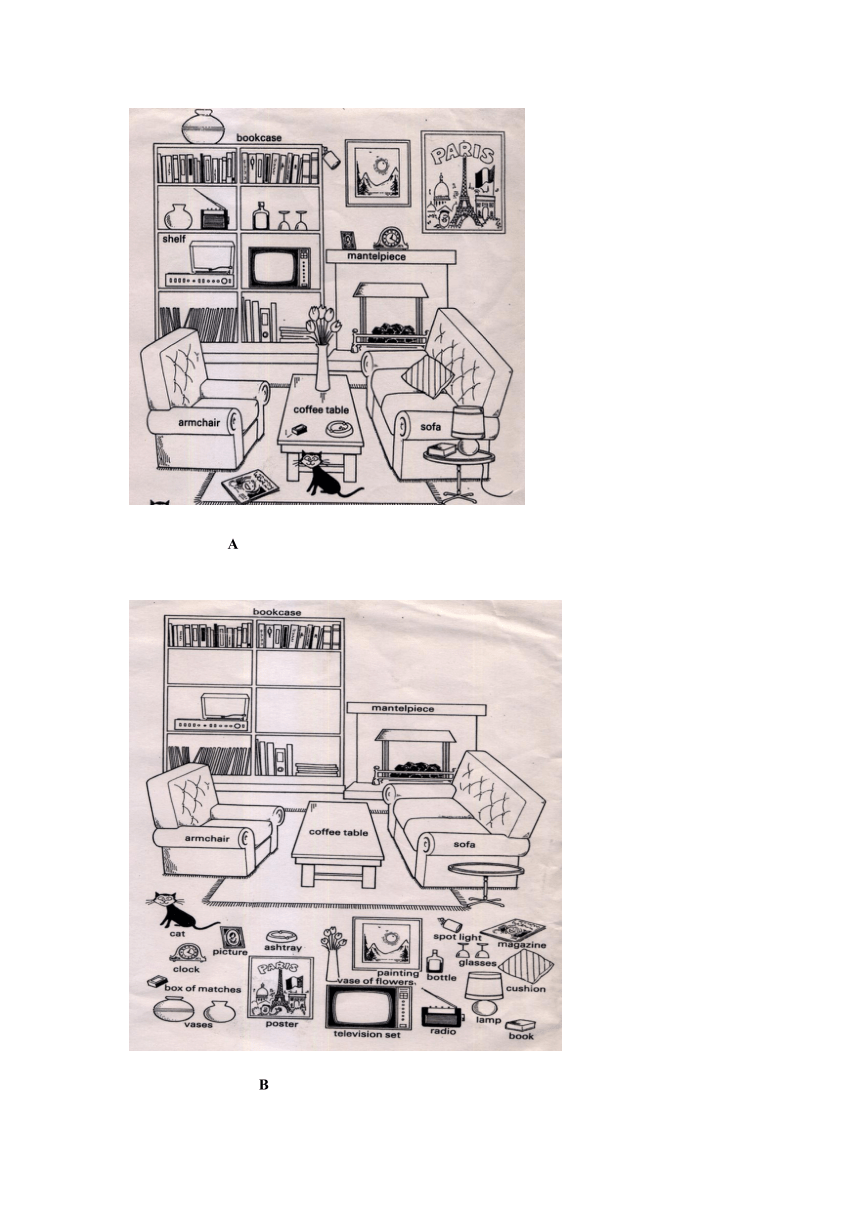Unit 4 Where’s my backpack? 全单元 [上学期]
文档属性
| 名称 | Unit 4 Where’s my backpack? 全单元 [上学期] |  | |
| 格式 | zip | ||
| 文件大小 | 3.5MB | ||
| 资源类型 | 教案 | ||
| 版本资源 | 人教新目标(Go for it)版 | ||
| 科目 | 英语 | ||
| 更新时间 | 2007-05-06 01:04:00 | ||
图片预览




文档简介
Unit 4 Where’ s my backpack
宁波外国语学校 郑飞
一、教材分析
中心话题:谈论物品的位置。
语言目标:要求学生熟悉物品的名称。
语言结构:能用Where 问句和一般疑问句提问,并用方位介词
来回答;注意名词的单复数;人称代词they的用法。
能力目标:通过对话练习,小组活动,小组竞赛等方式,
学会熟练地表达,并能从口头训练转向笔头训练。
二、教学目标
通过教学,学生能熟练地描述房间物品的摆设;能用英语发表个人
观点;能学会与他人交流和合作。
1. 认知目标
掌握有关物品的新单词:table, bed, dresser, bookcase, sofa,
chair, drawer, plant, bag, alarm, CD, video, video cassette, hat, ……
熟练运用 in, on, under, (beside, in front of, near) 等介词。
熟练运用 Where 问句和一般疑问句及其回答。
注意名词单复数的用法。
注意代词 they 的用法。
2. 能力目标
学会一些基本的学习策略,并运用这些策略提高运用英语的能力。
培养语用能力,让学生真正做到用中感悟,把所学到的语言知识与生活实际结合起来,使学习过程生活化。
培养英语思维能力和创新意识。
学会不断地发现问题,并用自己已有的知识水平和生活经历来解决实际问题。
Listing: Period 1: 列举出他们认为房间里可能有的物品。
Matching: Period 1: 单词和图片配对。
Ordering: Period 2: 对话的重新排序。
Comparing:Period 3: 找出两幅图之间的区别。
Problem solving: Period 4:讨论寝室里需要什么,然后写信给校长。
Rearranging : Period 4: 重新整理房间。
Designing : Period 5: 设计房间并在全班展示。
课时安排
Period 1 : Section A 1a~1c &3a~3c
Period 2 : Section A 2a~2b & 4
Period 3 : Section B 1a~ 3c
Period 4 : Section B 4 & Self check
1. Period One
Sub Topic Talk about the room
Language focus Talk about where the things are
Vocabulary bookcase, sofa, chair, backpack, books,keys, baseball, drawer, plant,in , on , under
Structure There is / are …Where is… It’s on / in / under…Where are… They’re in /on / under…
Tasks Listing
课前准备:
1、自己听录音,模仿跟读新单词。
(我们一直强调培养学生自主学习的能力的重要性,要求他们利用一切可利用的
学习资源。如:词典,录音磁带,网络等。同时,对于每一个单元的新单词要求
他们在新课开始前对其发音及意义能有初步的了解。)
Step One: Warming up.
Talk with the students about the things in the classroom by asking “What is it/are these ”
Step Two: New words learning.
A. A group competition between boys and girls to brainstorm what things are in a bedroom/a study/a living-room The group which can list more things is the winner.
B. Show the pictures of the things and learn the words: bookcase, bed, plant, dresser, drawer…
C. Cover the picture to have the students guess what it is / what they are
Step Three: Section A 1b
Step Four:
A. Learn the new words in ,on , under, near,… by helping the teacher find out the things she lost.
1. T: Where is my English book
S: It’s here.
T: Oh, it’s on the desk.
2. T : Where are my keys
S : They’re under your book.
3. T : Where is my dictionary
S : It’s in the backpack.
B. Teacher gives the orders like “ put the books on the pencil-case./ put your pencil in the pencil-case.” etc, and students do the actions.
C. Look for things.
The students hide and look for the things in groups. They can give the others
some clues. For example:
This is my book. It’s on the second desk.
(设计依据:通过设置让学生帮老师找东西这样一个真实的场景来导入新课,能够立刻调动学生的参与性,启动学习的发生。学生之间相互猜测能使他们的兴奋点持续下去。)
Step Five Pattern Drills
A: Where’s the plant
B: It’s on the floor.
Step Six Give two students two pictures of a living room. One picture has more objects in it, but the other doesn’t. The student with Picture B tries to put the things in the right places by asking the student with Picutre A questions “Where’s the…” or “ Where’re the … ”
A
B
Period Two
Sub Topic Talk about the room Find the difference
Language focus Talk about where the things are Tell the differences between two pictures
Recycled language There is /are…Where is … It’s on /in /under…Where are … They’re in /on/under…
Structure Is the book / Are the books on the desk Yes,… / No,… / I don’t know.
Tasks Listing Making a survey
Step One Warming up
1. Chat about the places of the things in the classroom.
2. Show a picture of a living room, let the students guess where the things (like the clock, chair, books, plant, keys )may be in the living –room.
Step Two: 1.Listen and number the things you hear in Section A 2a
2.Listen and find where the things are .
Step Three: According to the dialogue, make a similar one.
Step Four: Find the difference(Section A 4)
Show the students two pictures and let the students find the differences between the two pictures, using the patterns “In Picture One, the baseball is in under the table, but in Picture Two, the baseball is in the bag on the table”.
Step Five: Survey
Interview your classmate about his /her bedroom to see if his /her bedroom is tidy or untidy.
Example: A: Is there a desk in your room
B: yes
A: Where is it
Period Three
Sub Topic Asking for help
Language focus take… to ; bring… to ; need
Recycled language The book is on the table. The pens are in the pencil-case.
Language structure I need … for… Can you bring some things to school Please take these things to…
Tasks Comparing Problem solving & sharing
Step One Memory challenge between the boys and girls
1. Match the words with the things in the picture( Section B 1a)
2. Look at Tommy’s room for two minutes, then close the book and ask where the things are.
Girl: Where’s the math book
Boy: It’s on the dresser.
Step two: Listen and circle the things Tommy wants from his room (Section 2a-2b)
The thing(s) Tommy wants where
1
2
3
4
5
Step Three: Imitate the dialogue
Step Four: Dialogue making. You need some things for the sporting meeting. But you leave them at home. Now you’re telephoning your mum and asking your mum to bring them to school.
Step Five: Listen to the tape and try to draw the missing things in the picture.(3a)
Step Six: Look at the picture and fill in the blanks(3b)
Step Seven: Group work. Four students a group. Two students try to make a dialogue between the child and the mum. The child is asking mum to get four things from your room. One student tries to write a note to mum according to their dialogue. And the fourth student tries to write another note as mum to tell the son to take the things to his sister.
Period Four:
Sub topic Describe the room
Language focus In, on, under, near
Recycled language The book is on the table. The pens are in the pencil-case.
Language Structure I like … There is/ are….in/ on/near…
Tasks Comparing Problem solving & Sharing
Step One: Here are some pictures of a bedroom. Which bedroom do you like best Choose one and describe it. Let the students guess which bedroom you like .
Step Two: Design your ideal room
What kind of room do you want to have Two students a group try to design a room. It may be your bedroom, your study, your living-room.
宁波外国语学校 郑飞
一、教材分析
中心话题:谈论物品的位置。
语言目标:要求学生熟悉物品的名称。
语言结构:能用Where 问句和一般疑问句提问,并用方位介词
来回答;注意名词的单复数;人称代词they的用法。
能力目标:通过对话练习,小组活动,小组竞赛等方式,
学会熟练地表达,并能从口头训练转向笔头训练。
二、教学目标
通过教学,学生能熟练地描述房间物品的摆设;能用英语发表个人
观点;能学会与他人交流和合作。
1. 认知目标
掌握有关物品的新单词:table, bed, dresser, bookcase, sofa,
chair, drawer, plant, bag, alarm, CD, video, video cassette, hat, ……
熟练运用 in, on, under, (beside, in front of, near) 等介词。
熟练运用 Where 问句和一般疑问句及其回答。
注意名词单复数的用法。
注意代词 they 的用法。
2. 能力目标
学会一些基本的学习策略,并运用这些策略提高运用英语的能力。
培养语用能力,让学生真正做到用中感悟,把所学到的语言知识与生活实际结合起来,使学习过程生活化。
培养英语思维能力和创新意识。
学会不断地发现问题,并用自己已有的知识水平和生活经历来解决实际问题。
Listing: Period 1: 列举出他们认为房间里可能有的物品。
Matching: Period 1: 单词和图片配对。
Ordering: Period 2: 对话的重新排序。
Comparing:Period 3: 找出两幅图之间的区别。
Problem solving: Period 4:讨论寝室里需要什么,然后写信给校长。
Rearranging : Period 4: 重新整理房间。
Designing : Period 5: 设计房间并在全班展示。
课时安排
Period 1 : Section A 1a~1c &3a~3c
Period 2 : Section A 2a~2b & 4
Period 3 : Section B 1a~ 3c
Period 4 : Section B 4 & Self check
1. Period One
Sub Topic Talk about the room
Language focus Talk about where the things are
Vocabulary bookcase, sofa, chair, backpack, books,keys, baseball, drawer, plant,in , on , under
Structure There is / are …Where is… It’s on / in / under…Where are… They’re in /on / under…
Tasks Listing
课前准备:
1、自己听录音,模仿跟读新单词。
(我们一直强调培养学生自主学习的能力的重要性,要求他们利用一切可利用的
学习资源。如:词典,录音磁带,网络等。同时,对于每一个单元的新单词要求
他们在新课开始前对其发音及意义能有初步的了解。)
Step One: Warming up.
Talk with the students about the things in the classroom by asking “What is it/are these ”
Step Two: New words learning.
A. A group competition between boys and girls to brainstorm what things are in a bedroom/a study/a living-room The group which can list more things is the winner.
B. Show the pictures of the things and learn the words: bookcase, bed, plant, dresser, drawer…
C. Cover the picture to have the students guess what it is / what they are
Step Three: Section A 1b
Step Four:
A. Learn the new words in ,on , under, near,… by helping the teacher find out the things she lost.
1. T: Where is my English book
S: It’s here.
T: Oh, it’s on the desk.
2. T : Where are my keys
S : They’re under your book.
3. T : Where is my dictionary
S : It’s in the backpack.
B. Teacher gives the orders like “ put the books on the pencil-case./ put your pencil in the pencil-case.” etc, and students do the actions.
C. Look for things.
The students hide and look for the things in groups. They can give the others
some clues. For example:
This is my book. It’s on the second desk.
(设计依据:通过设置让学生帮老师找东西这样一个真实的场景来导入新课,能够立刻调动学生的参与性,启动学习的发生。学生之间相互猜测能使他们的兴奋点持续下去。)
Step Five Pattern Drills
A: Where’s the plant
B: It’s on the floor.
Step Six Give two students two pictures of a living room. One picture has more objects in it, but the other doesn’t. The student with Picture B tries to put the things in the right places by asking the student with Picutre A questions “Where’s the…” or “ Where’re the … ”
A
B
Period Two
Sub Topic Talk about the room Find the difference
Language focus Talk about where the things are Tell the differences between two pictures
Recycled language There is /are…Where is … It’s on /in /under…Where are … They’re in /on/under…
Structure Is the book / Are the books on the desk Yes,… / No,… / I don’t know.
Tasks Listing Making a survey
Step One Warming up
1. Chat about the places of the things in the classroom.
2. Show a picture of a living room, let the students guess where the things (like the clock, chair, books, plant, keys )may be in the living –room.
Step Two: 1.Listen and number the things you hear in Section A 2a
2.Listen and find where the things are .
Step Three: According to the dialogue, make a similar one.
Step Four: Find the difference(Section A 4)
Show the students two pictures and let the students find the differences between the two pictures, using the patterns “In Picture One, the baseball is in under the table, but in Picture Two, the baseball is in the bag on the table”.
Step Five: Survey
Interview your classmate about his /her bedroom to see if his /her bedroom is tidy or untidy.
Example: A: Is there a desk in your room
B: yes
A: Where is it
Period Three
Sub Topic Asking for help
Language focus take… to ; bring… to ; need
Recycled language The book is on the table. The pens are in the pencil-case.
Language structure I need … for… Can you bring some things to school Please take these things to…
Tasks Comparing Problem solving & sharing
Step One Memory challenge between the boys and girls
1. Match the words with the things in the picture( Section B 1a)
2. Look at Tommy’s room for two minutes, then close the book and ask where the things are.
Girl: Where’s the math book
Boy: It’s on the dresser.
Step two: Listen and circle the things Tommy wants from his room (Section 2a-2b)
The thing(s) Tommy wants where
1
2
3
4
5
Step Three: Imitate the dialogue
Step Four: Dialogue making. You need some things for the sporting meeting. But you leave them at home. Now you’re telephoning your mum and asking your mum to bring them to school.
Step Five: Listen to the tape and try to draw the missing things in the picture.(3a)
Step Six: Look at the picture and fill in the blanks(3b)
Step Seven: Group work. Four students a group. Two students try to make a dialogue between the child and the mum. The child is asking mum to get four things from your room. One student tries to write a note to mum according to their dialogue. And the fourth student tries to write another note as mum to tell the son to take the things to his sister.
Period Four:
Sub topic Describe the room
Language focus In, on, under, near
Recycled language The book is on the table. The pens are in the pencil-case.
Language Structure I like … There is/ are….in/ on/near…
Tasks Comparing Problem solving & Sharing
Step One: Here are some pictures of a bedroom. Which bedroom do you like best Choose one and describe it. Let the students guess which bedroom you like .
Step Two: Design your ideal room
What kind of room do you want to have Two students a group try to design a room. It may be your bedroom, your study, your living-room.
同课章节目录
- starters 预备篇(2012秋审查)
- Unit 1 Good morning !
- Unit 2 What’s this in English?
- Unit 3 What color is it ?
- Unit 1 My name's Gina.
- Section A
- Section B
- Unit 2 This is my sister.
- Section A
- Section B
- Unit 3 Is this your pencil?
- Section A
- Section B
- Unit 4 Where's my schoolbag?
- Section A
- Section B
- Unit 5 Do you have a soccer ball?
- Section A
- Section B
- Unit 6 Do you like bananas?
- Section A
- Section B
- Unit 7 How much are these socks?
- Section A
- Section B
- Unit 8 When is your birthday?
- Section A
- Section B
- Unit 9 My favorite subject is science.
- Section A
- Section B
